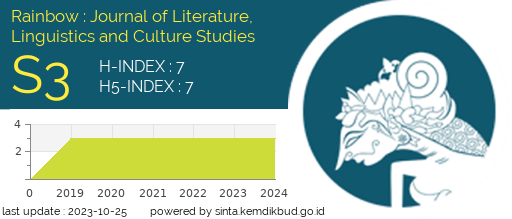Analysis of Maher Zain's "The Chosen One" Video Clip: Rolland Barthes Semiotic
DOI:
https://doi.org/10.15294/rainbow.v13i1.3196Abstract
Humans are inherently social beings, relying on communication for their survival. Video clips serve as a significant medium for expression and interpersonal connection. They hold the power to influence the public through visual narratives that complement lyrical content. Viewers often experience a direct emotional connection with the message conveyed in a video clip. In the case of Maher Zain's "The Chosen One," directed by Lena Khan, the narrative depicts the daily interactions of a Muslim individual within American society, predominantly comprised of non-Muslims. The video begins and ends with a textual reference to the inspiration drawn from Prophet Muhammad SAW, setting the thematic tone. This research endeavours to dissect the denotative, connotative, and mythological layers embedded within "The Chosen One" video clip. Music videos are complex constructs woven with various signs and symbol systems, combining visual and linguistic elements to encode messages. In this study, semiotic analysis, employing Roland Barthes' methodology, is utilized to uncover explicit meanings within the video clip. Barthes' framework distinguishes between denotation and connotation, with the latter delving into the realm of ideology or 'myth,' elucidating prevalent societal values. The findings of this research unveil the transmission of Islamic Shariah da'wah messages to the audience, emphasizing the integral role of Shariah in Islam. Shariah encompasses divine laws governing human relationships with the divine and with fellow beings, serving as a guiding framework for ethical conduct in daily life
Downloads
Published
Article ID
3196Issue
Section
License
Copyright (c) 2024 syamsurrijal (Author)

This work is licensed under a Creative Commons Attribution 4.0 International License.






